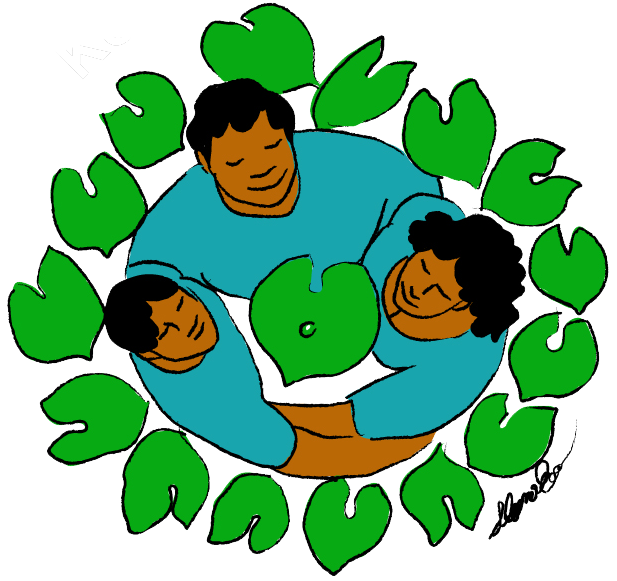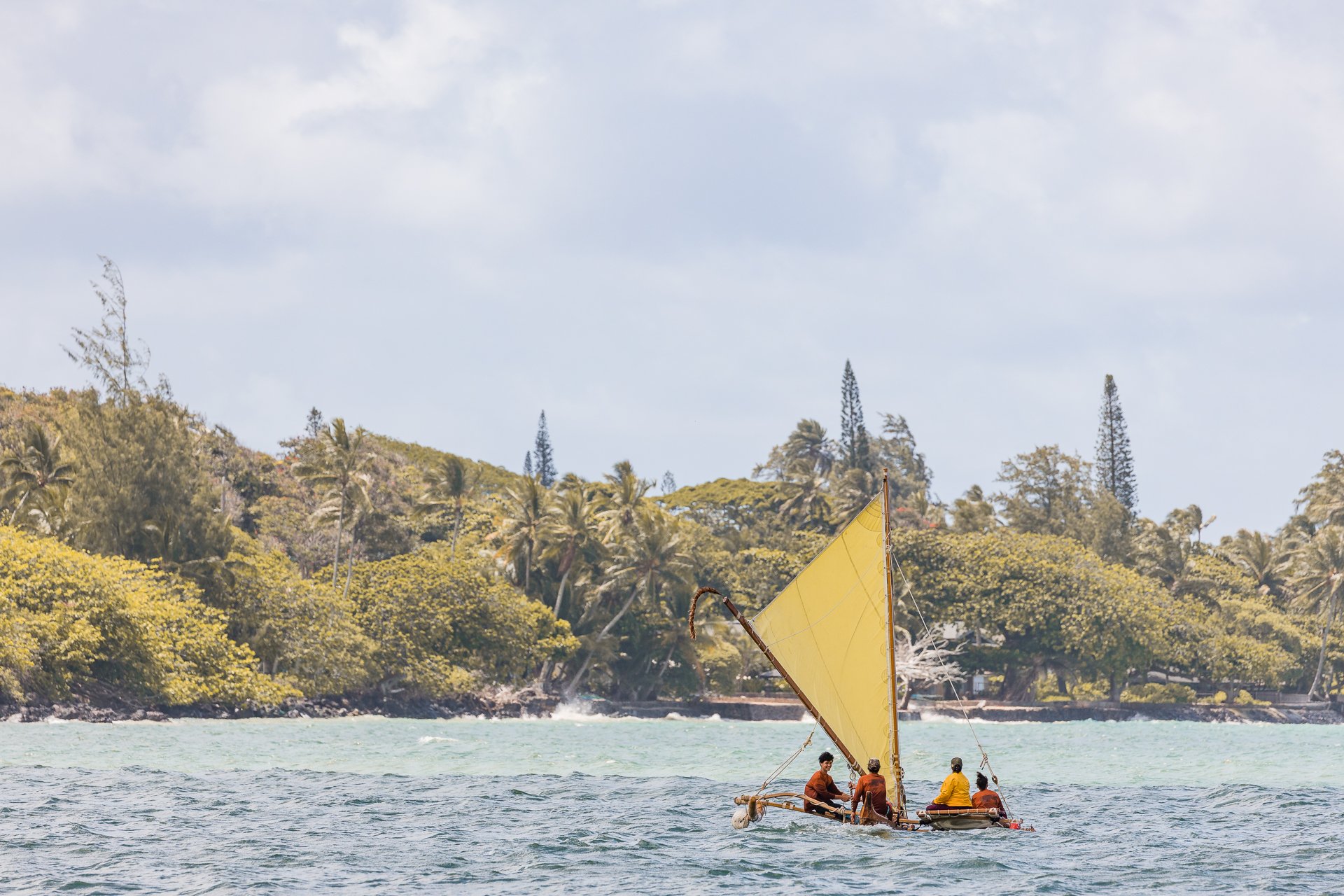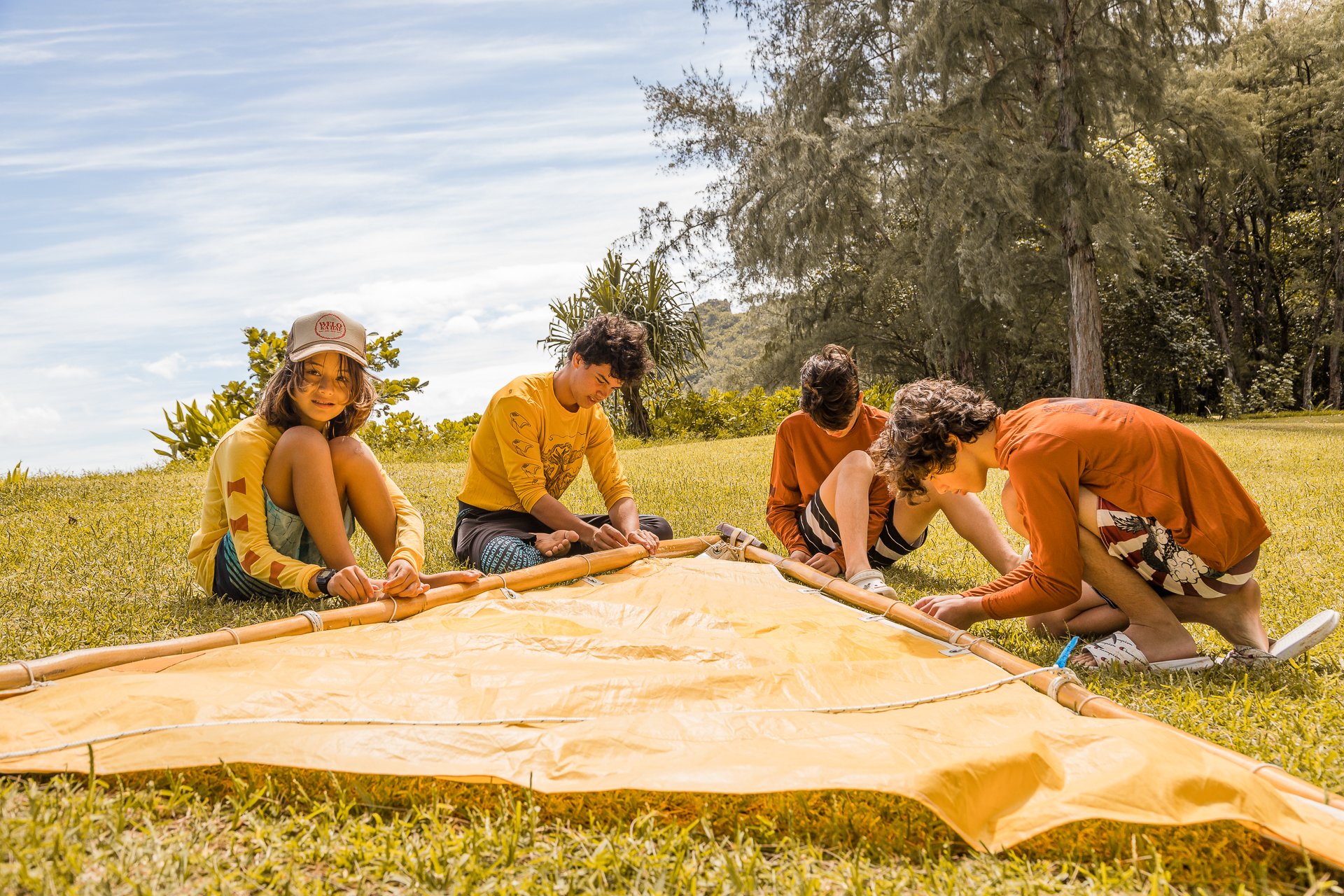Mai Uka Kuʻu Waʻa
My Beloved Canoe Comes From The Uplands
Waʻa sets sail in Kahana Bay. Photo: Kaʻōhua Lucas
KKV’s Mai Uka Kuʻu Waʻa (MUKW) program is a year-round Hawaiian immersion program for keiki and their families at Ho’oulu ‘Āina. During the school year, keiki aged 5-16 take part in monthly activities and, during the summer, spend 6 weeks doing daily activities that include planting and harvesting, ʻāina education, storytelling, arts and crafts, and more. This past June, the staff brought the keiki and their families to Kahana Beach for a week-long program where they worked with master carvers and storytellers, learned to paddle and to sail, and connected with their ancestral heritage.
The keiki who participate in this summer program spend the day in Kalihi valley planting seedlings and learning about the whole ahupuaʻa system. Photo: Kaʻōhua Lucas
“The waʻa or canoe has always been important in Hawaiian and Pacific cultures as a symbol of courage, strength, and resilience.”
“Where does the canoe start?” asks one of Hoʻoulu ʻĀina’s Mai Uka Kuʻu Waʻa educators. “In the forest as a tree,” the youth answer. The waʻa or canoe has always been important in Hawaiian and Pacific cultures as a symbol of courage, strength, and resilience. It is also a powerful vessel for teaching about the reciprocal and harmonious relationship between mauka and makai.
“For the kids, we want to show them that the waʻa is more than just sailing in the ocean; it is also connected with the trees growing in the forest,” says Kaʻōhua Lucas, one of the program's founders and kumu. “We think of it as canoes being ʻbornʻ into the forest,” she says, “and ask ourselves: How do we protect them?”
“We think of it as canoes being ʻbornʻ into the forest, and ask ourselves: How do we protect them?”
Kuʻuipo Gorospe, whose 5-year-old daughter Grace attends the program, remembers one of the first days of the program spent cleaning out and harvesting the māmaki plants. The keiki would say, “Thank you, māmaki,” while picking the leaves. She marvels that such a simple thing, “teaching them to be thankful; to honor and respect the ʻāina, and show mutual nurturing together has made such a big difference.” She observed that since Grace was treated so kindly by the older keiki who took her under their wing, she started to feel a sense of responsibility to help out whenever she could. Grace even started to wash her own dishes at home, a practice that she learned at MUKW.
“The program has been a source of inspiration for families to connect with the ʻāina and cultural learning, and to nurture their relationships with each other.”
Uncle Scotty shows keiki how to tie their knots in preparation for the hōʻike in the summer, when the waʻa they carved will be taken to sail at Kahana Bay. Photo: Kaʻōhua Lucas
The group originated with a core 35 keiki between the ages of 5—16, but the teachings radiate through the whole family as siblings, parents, aunties, uncles, and grandparents get involved. When the keiki come home excited about what they are learning, they want to tell the whole family and get them involved. ʻOhana members frequently participate in MUKW activities, like planting, storytelling, or art. The program has been a source of inspiration for families to connect with the ʻāina and cultural learning, and to nurture their relationships with each other.
The keiki work together to sand their waʻa to perfection for its maiden voyage. Photo: Kaʻōhua Lucas
For some of the keiki, the traditional school experience is fraught with obstacles. MUKW is a place where they can come to be exactly who they are, even if they do not fit into prescribed models of behavior and learning styles. The keiki are allowed to “unschool” themselves, and to think independently, based on what inspires them. As Kaʻōhua describes it, the program is not run like a typical organization because everyone's manaʻo is greatly appreciated. They believe that “Every tree holds mana and has a purpose...not just certain plants; everything in this place has value.”
For Kanoa Oʻconnor, a co-founder of the program and kumu, learning from our past and our kupuna is as important as looking seven generations into the future. One of the goals of the program, he says, is to “identify the gifts of our children, and to prepare the next generation of leaders in our community. We want to be very intentional about what is being taught and learned...and we're hoping [this idea] will grow and grow.”
The group learned to refine their nautical knots, lash the sail, and blow the pū. They learned to prepare themselves and everything needed to embark on this journey. Photo: Kaʻōhua Lucas









